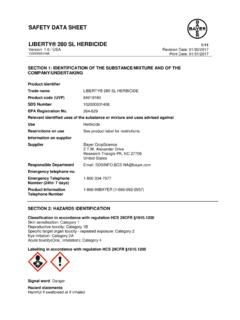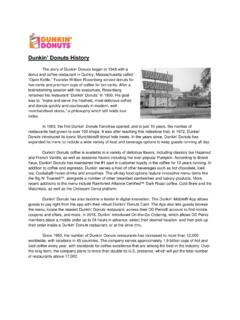Transcription of COR Milestone 011221 SpecLbl
1 Specimen Label Trademarks of Dow AgroSciences, DuPont or Pioneer and their affiliated companies or respective owners For control of annual and perennial broadleaf weeds including invasive and noxious weeds, certain annual grasses, and certain woody plants and vines on: rangeland, permanent grass pastures (including grasses grown for hay*), Conservation Reserve Program (CRP); non-crop areas for example, airports, barrow ditches, communication transmission lines, electric power and utility rights-of-way, fencerows, gravel pits, industrial sites, military sites, mining and drilling areas, oil and gas pads, non-irrigation ditch banks, parking lots, petroleum tank farms, pipelines, roadsides, railroads, storage areas, dry storm water retention areas, substations, unimproved rough turf grasses; natural areas (open space) for example, campgrounds, parks, prairie management, trailheads and trails, recreation areas, wildlife openings, and wildlife habitat and management areas including seasonally dry flood plains, deltas, marshes, prairie potholes, or vernal pools; including grazed areas in and around these sites.
2 *Hay from grass treated with Milestone within the preceding 18 months can only be used on the farm or ranch where the product is applied unless allowed by supplemental USE PRECAUTIONS AND RESTRICTIONS TO PREVENT INJURY TO DESIRABLE PLANTS Carefully read the section Restrictions in Hay or Manure Use. It is mandatory to follow the Use Precautions and Restrictions section of this label. Manure and urine from animals consuming grass or hay treated with this product may contain enough aminopyralid to cause injury to sensitive broadleaf plants. Hay can only be used on the farm or ranch where product is applied unless allowed by supplemental labeling. Consult with a Dow AgroSciences representative if you do not understand the Use Precautions and Use Restrictions. Call 1-800-258-3033 Customer Information Group. Copyright 2011 Dow AgroSciences LLCAMINOPYRALIDGROUP4 HERBICIDE 2 Specimen Label Revised 01-12-21 Not for Sale, Sale into, Distribution, and/or Use in Nassau and Suffolk counties of New York State.
3 Active Ingredient: Triisopropanolammonium salt of 2-pyridine carboxylic acid, 4-amino-3,6-dichloro- .. Ingredients .. Acid Equivalent: aminopyralid (2-pyridine carboxylic acid, 4-amino-3,6-dichloro-) - - 2 lb/gal Container Use Directions Precautionary Statements Hazards to Humans and Domestic Animals EPA Reg. No. 62719-519 Keep Out of Reach of ChildrenCAUTION Causes Moderate Eye Irritation Avoid contact with eyes or clothing. Personal Protective Equipment (PPE)Applicators and other handlers must wear: Long-sleeved shirt and long pants Shoes plus socks Follow manufacturer's instructions for cleaning/maintaining PPE. If no such instructions for washables exist, use detergent and hot water. Keep and wash PPE separately from other laundry. User Safety RecommendationsUsers should: Wash hands before eating, drinking, chewing gum, using tobacco or using the toilet. Remove clothing/PPE immediately if pesticide gets inside.
4 Then wash thoroughly and put on clean clothing. Remove PPE immediately after handling this product. Wash the outside of gloves before removing. As soon as possible, wash thoroughly and change into clean clothing. First AidIf in eyes: Hold eye open and rinse slowly and gently with water for 15-20 minutes. Remove contact lenses, if present, after the first 5 minutes, then continue rinsing. Call a poison control center or doctor for treatment advice. Have the product container or label with you when calling a poison control center or doctor or going for treatment. You may also contact 1-800-992-5994 for emergency medical treatment information. Environmental HazardsDo not apply directly to water. Take care to minimize the incidental overspray along the shoreline when applying to terrestrial plants at the water s edge or to water in areas where surface water is present. Do not apply directly to intertidal areas below the mean high water mark.
5 Do not contaminate water when disposing of equipment washwater or rinsate. This chemical has properties and characteristics associated with chemicals detected in groundwater. The use of this chemical in areas where soils are permeable, particularly where the water table is shallow, may result in groundwater contamination. Application around a cistern or well may result in contamination of drinking water or groundwater. Directions for UseIt is a violation of Federal law to use this product in a manner inconsistent with its all Directions for Use carefully before applying. This product is not intended for reformulation or repackaging into other end-use products. Do not apply this product in a way that will contact workers or other persons, either directly or through drift. Only protected handlers may be in the area during application. For any requirements specific to your State or Tribe, consult the agency responsible for pesticide regulation.
6 Not for Sale, Sale into, Distribution, and/or Use in Nassau and Suffolk counties of New York State. Not for use on pastures in Connecticut, Maine, Massachusetts, New Hampshire, New York, Rhode Island, and Vermont. All other labeled uses are permitted in these states including grazed areas in and around these sites. New YorkVermontMaineMassachusettsNew HampshireRhode IslandConnecticut Agricultural Use Requirements Use this product only in accordance with its labeling and with the Worker Protection Standard, 40 CFR part 170. This Standard contains requirements for the protection of agricultural workers on farms, forests, nurseries, and greenhouses, and handlers of agricultural pesticides. It contains requirements for training, decontamination, notification, and emergency assistance. It also contains specific instructions and exceptions pertaining to the statements on this label about Personal Protective Equipment (PPE) and restricted-entry interval.
7 The requirements in this box only apply to uses of this product that are covered by the Worker Protection Standard. Do not enter or allow worker entry into treated areas during the restricted entry interval (REI) of 48 hours. PPE required for early entry to treated areas that is permitted under the Worker Protection Standard and that involves contact with anything that has been treated, such as plants, soil, or water, is: Coveralls Chemical-resistant gloves made of any waterproof material as polyethylene or polyvinyl chloride Shoes plus socks Protective eyewear Non-Agricultural Use RequirementsThe requirements in this box apply to uses of this product that are NOT within the scope of the Worker Protection Standard for Agricultural Pesticides (40 CFR Part 170). The WPS does not pertain to non-agricultural use on sites, such as, rangeland, permanent grass pastures, or non-cropland. See the Agricultural Use Requirements section below for information where the WPS applies.
8 Entry Restrictions for Non-WPS Uses: For applications on rangeland and permanent grass pastures (not harvested for hay) and non-cropland areas, do not enter or allow worker entry into treated areas until sprays have dried. Storage and DisposalDo not contaminate water, food, feed, or fertilizer by storage or disposal. Open dumping is Storage: If this product is exposed to subfreezing temperatures, the active ingredient may crystallize and settle out of solution. Under these conditions the product should be warmed to at least 40 F and agitated well to dissolve any crystallized active ingredient prior to Disposal: Wastes resulting from the use of this product may be disposed of on site or at an approved waste disposal facility. Nonrefillable containers 5 gallons or less:Container Handling: Nonrefillable container. Do not reuse or refill this container. Offer for recycling if available, or puncture and dispose of in a sanitary landfill, or by incineration, or by other procedures allowed by state and local = states where use in pasture is not permitted 3 Specimen Label Revised 01-12-21 Storage and Disposal (Cont.)
9 Triple rinse or pressure rinse container (or equivalent) promptly after emptying. Triple rinse as follows: Empty the remaining contents into application equipment or a mix tank and drain for 10 seconds after the flow begins to drip. Fill the container 1/4 full with water and recap. Shake for 10 seconds. Pour rinsate into application equipment or a mix tank or store rinsate for later use or disposal. Drain for 10 seconds after the flow begins to drip. Repeat this procedure two more times. Pressure rinse as follows: Empty the remaining contents into application equipment or a mix tank and continue to drain for 10 seconds after the flow begins to drip. Hold container upside down over application equipment or mix tank and continue to drain for 10 seconds after the flow begins to drip. Hold container upside down over application equipment or mix tank or collect rinsate for later use or disposal. Insert pressure rinsing nozzle in the side of the container, and rinse at about 40 psi for at least 30 seconds.
10 Drain for 10 seconds after the flow begins to drip. Refillable containers larger than 5 gallons:Container Handling: Refillable container. Refill this container with pesticide only. Do not reuse this container for any other the container before final disposal is the responsibility of the person disposing of the container. Cleaning before refilling is the responsibility of the refiller. To clean the container before final disposal, empty the remaining contents from this container into application equipment or a mix tank. Fill the container about 10% full with water. Agitate vigorously or recirculate water with the pump for two minutes. Pour or pump rinsate into application equipment or rinsate collection system. Repeat this rinsing procedure two more times. Nonrefillable containers larger than 5 gallons:Container Handling: Nonrefillable container. Do not reuse or refill this container. Offer for recycling if available, or puncture and dispose of in a sanitary landfill, or by incineration, or by other procedures allowed by state and local rinse or pressure rinse container (or equivalent) promptly after emptying.













